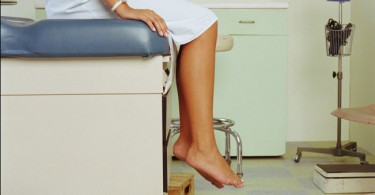
Sponsored Links
Sex is supposed to be fun, and it’s definitely not supposed to hurt.
But one of the consequences of menopause is vaginal dryness, which for many women means painful sex.
With the loss of ovarian estrogen, vaginal walls that were once elastic, expandable, supple and sturdy can, over time, become tightened and fragile. The vaginal walls can become as thin as tissue paper, unable to withstand the manipulation that occurs with sexual activity, and can tear and even bleed with intercourse.
“Use it or lose it”
When sex becomes painful, the natural response is to begin to avoid intercourse. But without continued sexual activity (masturbation counts, too), the vagina becomes even smaller and tighter, making a bad problem even worse. Add in a partner with erectile dysfunction and it’s not unusual for a woman to present to me not having had sex in a year or more, wondering if there’s anything that can be done to get back the sex life she and her partner once enjoyed.
Fortunately, the answer is almost always a resounding “Yes!”
Non-Hormonal Treatment
The first step for most women is a trial of non-hormonal therapy. You’ll need two things – a moisturizer and a lubricant.
Vaginal moisturizers
Think of how you take care of your skin – you moisturize it daily, right? Well, the menopausal vagina needs the same thing. It doesn’t have to be every day, but it has to be regular and consistent.
I don’t promote products, but I do tell my patients about Replens - it’s been studied and shown to be as effective as vaginal estrogen in restoring the premenopausal vaginal mucosa.
Vaginal Lubricants
Have fun trying out brands, but avoid flavored and scented products if you tend to be sensitive to them. If you need STD protection, stick to water-based lubricants that will not degrade condoms.
Don’t be shy about using lube – slather it on him and yourself and have fun.
Vaginal Estrogen Treatment
Probably the most effective treatment for dryness is vaginal estrogen. It works by restoring and thickening the mucous membranes in the vagina (vaginal mucosa), and by increasing vaginal secretions.
Vaginal estrogen comes in one of three forms –Estradiol tablets (Vagifem) and Estrogen vaginal creams (Estrace and Premarin), used twice a week, and the estradiol vaginal ring (Estring), which lasts three months. All three types of estrogen are effective, though my patients often have trouble remembering the twice a week regimens for tablets and cream. Estrogen doses are lowest for the ring and highest for the cream, but one can adjust the dose by simply using less cream. This allows for higher doses at the beginning of treatment, with lower maintenance doses once vaginal integrity and sexual function are restored.
Advertisements
Safety of vaginal estrogens
Women hear the word “estrogen” and immediately become concerned – not surprising given the findings of the Women’s Health Initiate in 2002 that hormone replacement is associated with a small increase in breast cancer risks. However, estrogen exposure from use of vaginal estrogen is much lower than that with hormone replacement, and blood levels of estrogen remain within the menopausal range. These small amounts of estrogen do not carry the same risks of blood clots as does hormone replacement, and there is no increase in uterine cancer rates with vaginal estrogen use for up to 5 years. Despite these differences, vaginal estrogens carry the same FDA warnings as systemic hormone replacement, and menopause experts have petitioned the FDA to correct the vaginal estrogen package insert.
All of that said, we do not have long-term data on breast cancer risks from vaginal estrogen, and women at high risk for breast cancer or with a history of breast cancer generally want to avoid even the small amounts in vaginal estrogen, especially if they are taking aromatase inhibitors to lower breast cancer risks. If non-hormonal treatment are ineffective, some high risk women may be willing to use a short course of estrogen to restore vaginal integrity and sexual function, followed by over the counter moisturizers for long-term maintenance therapy.
What About Estriol Cream?
Estriol is a weak estrogen that is effective for vaginal dryness, but is not FDA-approved. If you’re avoiding the FDA-approved products because you don’t want to take estrogen, then take estriol off the list as well. It’s just another estrogen.
Oral Treatment
Ospemifine (Osphena) is an oral SERM (Selective Estrogen Receptor Modulator) that in the vagina, acts like estrogen, restoring vaginal moisture and the integrity of the vaginal mucosa. Ospemiphene can stimulate growth of the uterine lining, although in postmenopausal women, this effect is minimal. It does carry a small blood clot risk, although it is less than that of hormone replacement. One side effect of Ospemiphene is hot flashes.
Vaginal Dilators
If you’ve been menopausal and celibate for a long time, estrogen and lubricants may not enough to restore normal sexual activity. In that case, your doctor can prescribe a set of vaginal dilators – soft plastic rods that come in graduated sizes from 3 mm to 10 mm in diameter, allowing for a gradual increase in vaginal capacity.
Not every patient I’ve offered dilators feels up to the task. In that case, they confine their sexual activities to non-penetrative sex, which for many women is where the fun is anyway.
Which brings me to…
The Forgotten Art of Foreplay
Over years of being together, what with children and a busy life, some couples may have gotten out of the habit of foreplay, but have had a very satisfactory sex life just getting down to business.
But now, what with her vaginal dryness and his erectile dysfunction, the old “Wham, Bam, thank you Ma’am” may not work so well anymore. The good news is that there is now time to rediscover the joy of foreplay, as well as the wide variety of intimacies other than intercourse.
One more piece of advice about getting started again with sex.
If, because of dryness, it’s been awhile since you’ve had sex, don’t start treatment and then sit and wait for the urge to hit you to start having sex again. Your libido is not going to suddenly turn back on just because your vagina is ready.
You’re just going to have to do it anyway, whether you think you want to or not. If all goes well, your body will respond – “Oh yeah – Now I remember – this is fun!”
by Margaret Polaneczky, MD



Comments